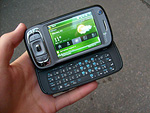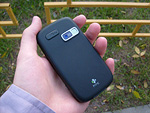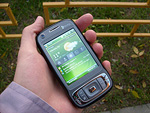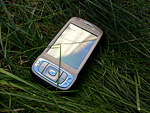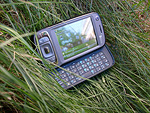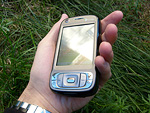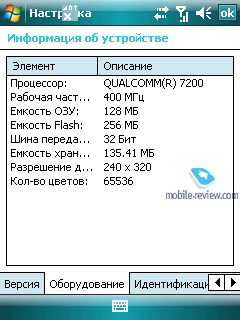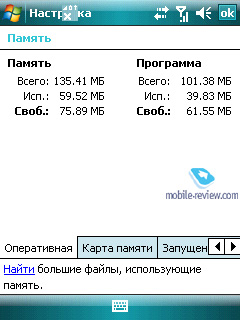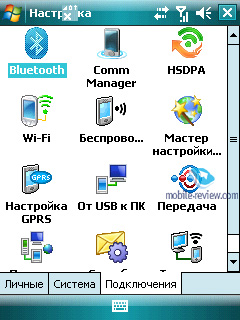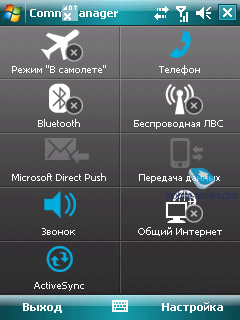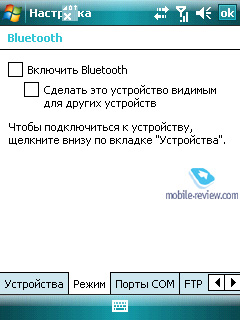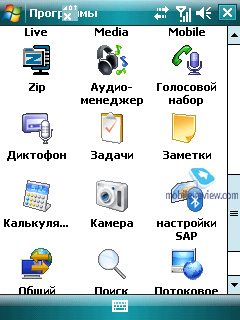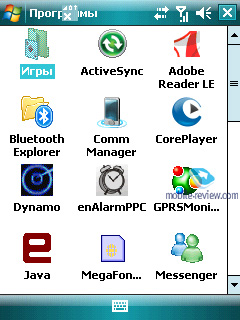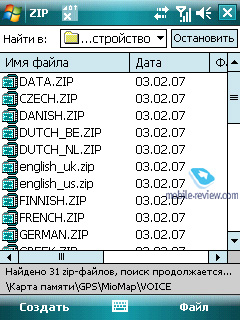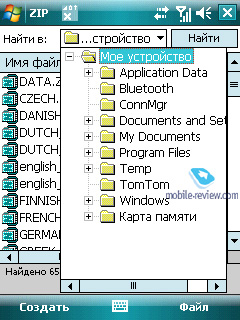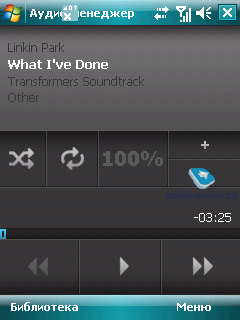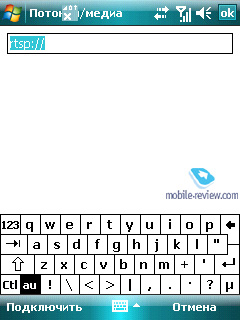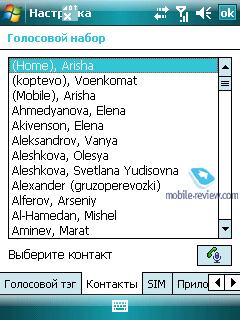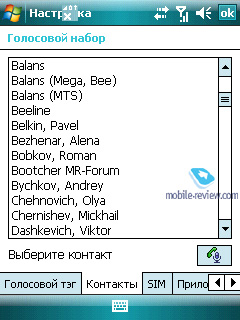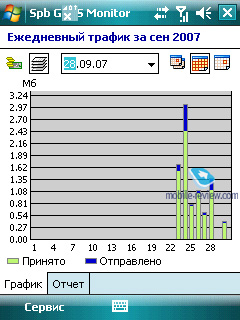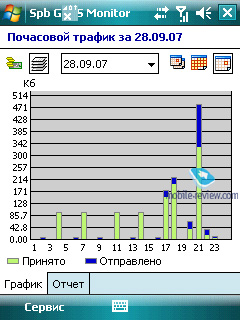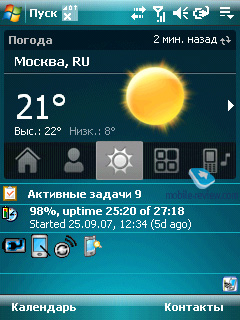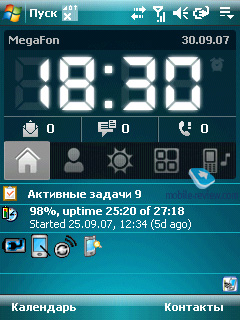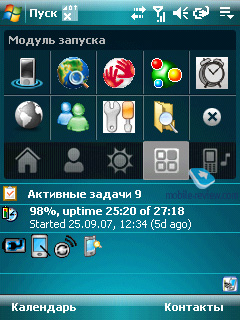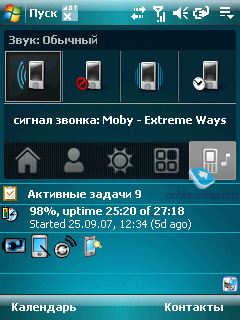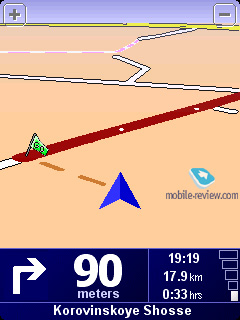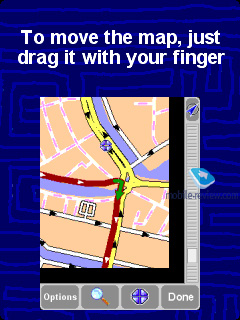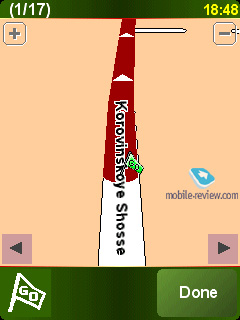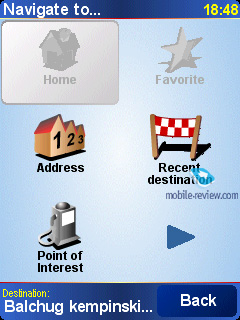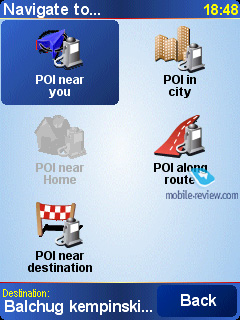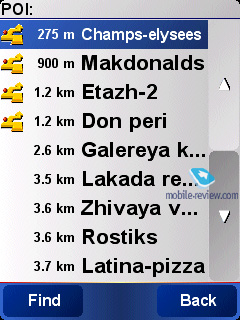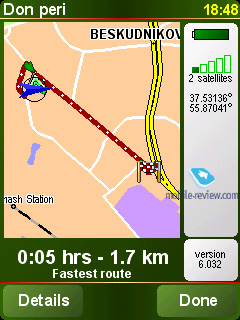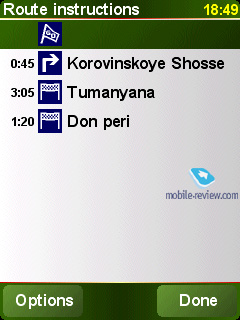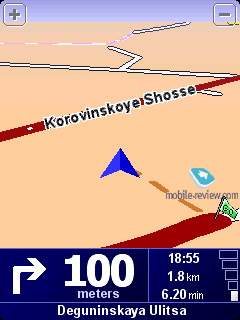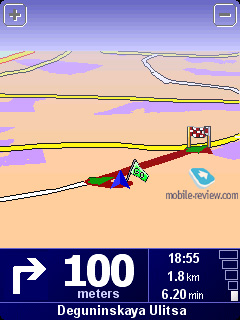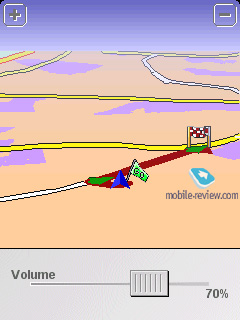Review of QWERTY-communicator HTC TyTN II
Live photos of HTC TyTN II
Table of contents:
- Preface
- Design
- Casing, slider action
- Dimensions, controls layout
- Controls, QWERTY-keyboard
- Display
- Camera
- Battery life
- Performance
- Connectivity
- Software
- GPS
- Sales package, sonic experience
- Conclusion
Sales package
- Communicator
- Battery (1350 mAh)
- User Guide
- Charger
- Software CD (ActiveSync and Outlook)
- Software CD 2 (TomTom Navigator, SPB GPRS Monitor)
- miniUSB data cable
- Stereo-headset
- Carrying case
Preface
The Kaiser was one long-awaited phone. It was almost half a year between the moment when first notes and rumors about it spread across the Web and its official announcement. But curiously, during all these months, the company didn’t seem to care much about this device, in contrast to, say, the HTC P5500/Nike, the next touch-phone in HTC’s portfolio.
Initially, the new thumbboard-enabled communicator, just like all other solutions, had both its codename and index – that is, the Internet buzzed about the HTC Kaiser or the HTC P4550, which meant the same thing. For HTC it is a milestone model for several reasons. Firstly, the TyTN II ushers in the era of Qualcomm’s platform for the company, being sort of a proving ground. Secondly, it retains the slide-slider-with-tilting-display form-factor, which is first seen with the HTC TyTN II.
Despite the slew of differences from the original TyTN, the new handset comes in as the TyTN II, which is not a fluke by any means – for some models the company starts employing codenames instead of indexes. It might look more like a mess than a consistent way to name its solutions, since for the most part HTC has been sticking to indexes, and only few models have had codenames. But this is what the company sees as its philosophy, in a way – codenames are granted to unique models, which are second to none in terms of certain aspects. And the TyTN II fits this concept really well.
With the debut of this handset, the company establishes a new series, like the one it did when the HTC Touch Dual was set loose. This way, HTC feature two developed product ranges – the Touch Series and the TyTN Series.
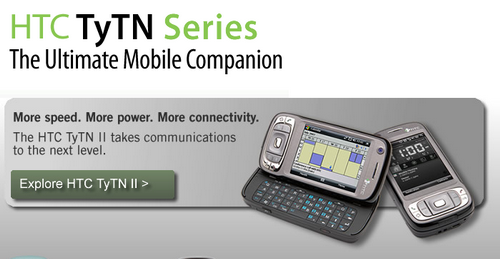
However on the face of it, the big picture looks somewhat odd. While it is a milestone product for the company itself, on the other hand, it is already included into a line-up and employs the name of the original TyTN, popular with many WM-users. The communicator’s price, even before its release, puts it in one league with the most expensive communicators, making it an elite offering, even though it is more like a proving ground for the company, rather than a commercially important product.
Let’s figure out what this new HTC-branded QWERTY-communicator brings to the table.

Back to the table of contents >>>
Design
In this reviewer’s opinion, the developers have made this communicator look pretty decent by striking the right balance between classy shapes and unfussy design. So the end result doesn’t feel boring or prosy, however the TyTN II’s looks isn’t flashy or flamboyant in any way, which indicated what a great job the company and its designers have done.
Remember the original TyTN with its grey casing and minimalist design. Back then HTC was after only one thing – a no-nonsense device that wouldn’t put people off. That’s the reason its design came out quite insipid and overly severe.
To rectify the letdown of its predecessor, the TyTN II enjoys a very fitting solution – it combines differently patterned plastic types and metal. The front plate, the display rim and key frames are all made of metal, while the casing utilizes plastic finished in a way to resemble a chrome-coated surface. The inners of the phone make use of dark-grey plastic, and a glossy plastic strip runs all around the edge of the TyTN II. In fact, the latter proved to be the most disputable design component – half of those who played around with the model loved it, while others deemed it pointless.


Furthermore, at a glance this edging might also worry you since this surface type usually picks up scratches and scuffs with ease. However, in our case, after three weeks of quality time with the TyTN II, this strip remained in pristine condition. Nevertheless, we will reserve our final judgment until later, for the time span of three weeks is kind of short to tell something for sure, but there is one thing we are confident of – it won’t get scratched all over right after you take the communicator out of the box.

The side plates are made of somewhat rough plastic. Running all around the sides are small hair-wide dents which makes for comfortable and non-slippery fit in the hands.
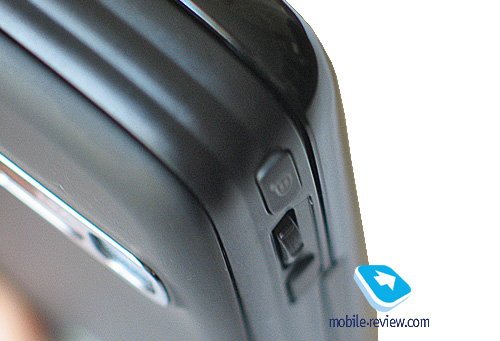
The back side of the TyTN II is made of soft-touch plastic, thanks to this it feels great and doesn’t attract finger prints or scratches.

Combined, these details, different surface types and color mixes deliver the impression of an expensive and high-quality device. The model, and this is the best definition we can think of, is classy in its modesty.
Back to the table of contents >>>
Casing, slider action
Given this side-slider’s design traits, the build quality is one of the TyTN’s centerpieces. All details feel very solid, no gaps or loose-fitting parts. The keypad area is nothing to worry about either. The back cover sits in a couple of notches and can be slid open by pulling it forwards. Since the entire underside in fact is the battery cover, it feels very solid, no loose feel to it whatsoever.


Right after the moment when first shots picturing the communicator popped up on the Web, there were some heated debates whether this form-factor was of any use. While it is something we have already seen from HTC (side-slider form-factor in the TyTN, and in theP4350), the ability to tilt the display up sort of questioned the durability of this form-factor as well as its usability.
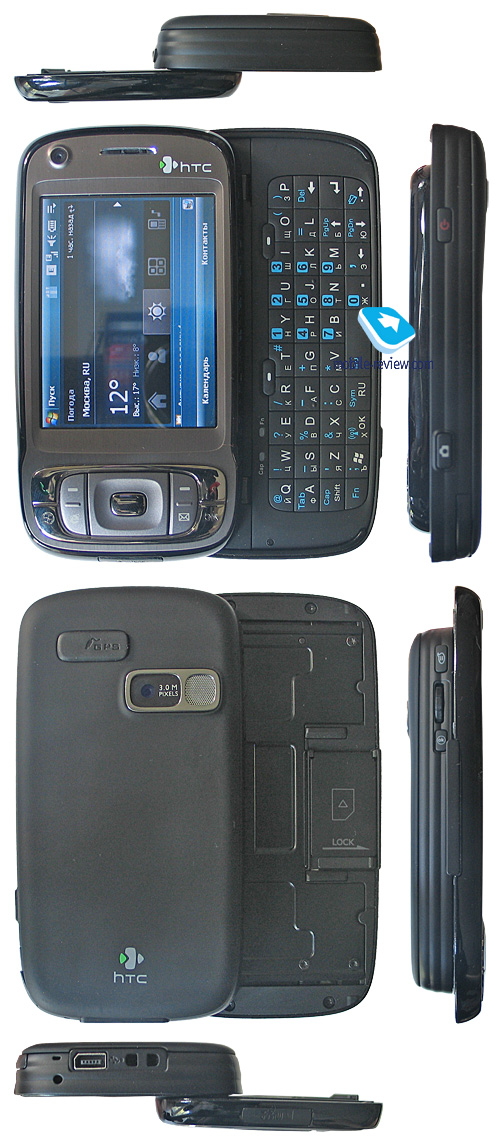
The device comes with a spring loaded mechanism which does a fine job helping you to slide the TyTN II open. Even with the model’s substantial weight and size in mind, the halves move like two feathers in different directions – all you need to do is push the half retaining the display to the left. Basically, there are many ways to get the device open, but, as wee see it, all left-handers won’t find it comfortable to use, so before going for this model, you better pay close attention to this aspect, if it is of any importance to you.
The screen tilting mechanism makes its first appearance in HTC-branded devices with the TyTN II – it is an all-around new experience for the company, which has already been adopted in the HTC Shift as well. Two hinges enabling this form-factor are mounted under the top half when the TyTN II is open.

On the inside of the lower slide are two rubber borders which prevent the TyTN II from gliding closed when the display is tilted up – should you angle it down and try to zip the phone closed, then the top half will bump into these pads and return to the original position.

It is a bit early to judge the TyTN II’s durability – it is worth waiting for some feedback, but on the face of it the screen tilting mechanism feels sturdy and well-made. The tilt angle may be manually adjusted (max - 30° to the bottom slide), and you will always have the display firmly fixed in any position.
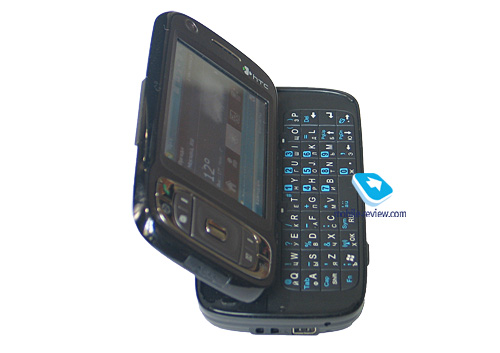
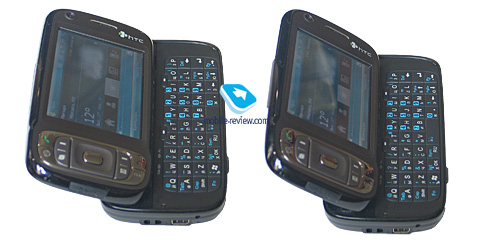
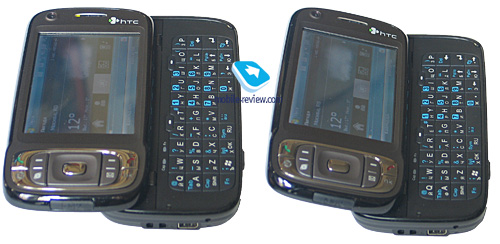
Let’s try to think of some ways the user could make use of the new HTC’s design. The first thing that comes across you mind is the “desktop” scenario with the TyTN II lying on a table with its display tilted up, which makes it resemble a notebook. And in theory this setup should make for convenient text typing.

But in practice it turns out that this setup isn’t the best way for texting due to several reasons. Fist, since the device itself is pretty much portable, the thumbboard is smallish as well, that’s how come you won’t be happy about using both hands for typing (like you do when dealing with a standard-size keyboard). Your fingers will always tangle and stand in each other’s way, so you won’t even see key caption or even the keys themselves. But even if you manage to get used to this, you will need to type with only two fingers regardless.
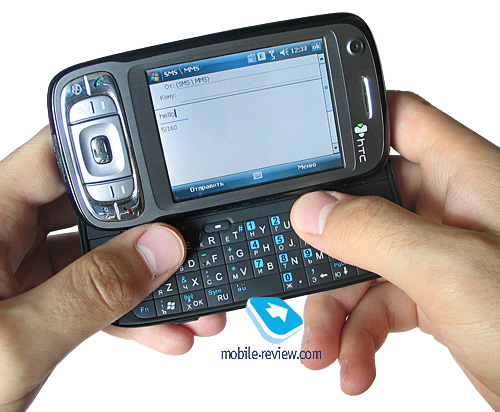
Another possible application for the setup is one-the-go typing – that’s the scenario when it proves to be more useful. While it might seem that when holding the TyTN II in hands, texting with the display set in the standard position is handier, it turns out that having the screen slightly tilted up is better. It allows you to hold the communicator in the way you like, so texts become easier to read and to type.
There is nothing revolutionary in the TyTN II’s screen tilting mechanism – on the whole, it is just another amenity to hype the communicator, and a pleasant option for its users. Some will find it helpful, some not, and there is nothing wrong with that – you may never tilt it up if you don’t like this setup.
Back to the table of contents >>>
Dimensions, controls layout
Now let’s see how big the TyTN II is, and examine its controls layout a tad closer. Actually, this is the place where the communicator packs a couple of pretty odd surprises.
First off, its dimensions are way beyond what we normally mean by “portable”. The TyTN II is huge, compared to other recently debuted device. But on the other hand, it is pretty much in one league with the glofiish M700 or the original TyTN, furthermore, the TyTN II turns out to be slightly more compact than its predecessor.

- HTC TyTN – 113x58x22 mm, 176 g
- HTC TyTN II – 112x59x19 mm, 190 g
- Glofiish M700 – 117.5x59x20 mm, 165 g
The model sure is a heavyweight, and this does impact its ergonomics in certain ways, specifically its ability to slip into breast pockets of shirts. Obviously, it will look out of place there solely because of its overweight. As regards other pockets you might throw it into, like jeans or trousers, these are all suitable places, however even there you might feel some discomfort, again, due to its weight. So the best place to have the TyTN II in – outerwear or the carryin case that comes packaged with the device. Among all other things, the communicator is quite palm-friendly.

Topping the front fascia is an earpiece and sitting right next to it is a mini camera for videoconferencing, which can also be used for self-portraits, when you switch to it in the camera menu. Flanking the earpiece are two LED indicators.

The one on the left glows in green or yellow notifying you of GSM- and UMTS- modules (green) activity, new messages or alerts (yellow). It also starts blinking in red when the battery level goes below 5%. The indicator on the right stands for wireless connectivity options status – blue obviously means Bluetooth, and green – WiFi, while its green lights will inform you about the activated GPS-module.
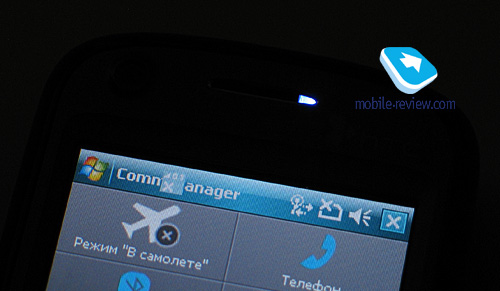
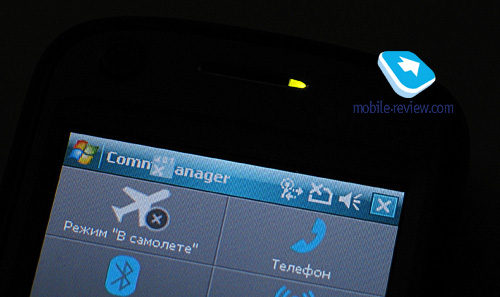
Housed on the left-hand spine is a scroll wheel, which is a rarity among all new offerings. Before this moment, only the HTC TyTN and the HTC P3600 (Trinity) incorporated this control. The unit found on the TyTN II is reasonably tight and quite sensitive. With its help you can soar through lists and menus in the standby mode and adjust the volume level during calls. Tapping the wheel opens menu items and launches applications. Sitting below the wheel is the OK buttons, which does three things: while at the Today screen it opens the Start menu; while in some menu item or application, pressing the side-mounted OK key returns you to the Today screen; and while reading mail or handing the contact list, this button gets you one level back. This way, the HTC TyTN II can satisfy all your basic navigation needs (mail browsing, web-surfing, application management) with only two controls – the scroll wheel and the side-mounted button, which is very convenient in some cases, so you don’t have to pull out the styles every time you need to perform some basic actions, and nor do you need both hands for these purposes.


Topping these controls is the voice dial button.
The right-hand spine hosts the power key, looking at the bottom you will also find the dedicated camera button (tap it to focus and press it to make a shot), which is reasonably stiff.


The bottom right corner is occupied by a tight stylus silo. The stylus’s handle has a ledge, which you can hook to pull it out of its nest. The stylus itself is a standard HTC fare, meaning that it is neither long nor short. So if you have already grown found of a long and thick stylus of some PDA, then the TyTN II’s unit will take some getting used to.


The communicator’s base houses the ExtUSB socket for charging, data cable connections, as well as headsets or earphones (via a compatible adaptor). Not too far away from it is the microphone and the lanyard eyelet. Next to the microphone sits soft reset button slightly recessed into the casing. Looking up at the top slide you will find the memory expansion slot; the TyTN II has support for microSDHC cards (standard SD 2.0), in other words you can stick any memory card of the given type you can find today into it.

The socket is covered by a flap, linked to the casing and rotates to make sure you can reach the socket itself. However its design leaves much to be desired – the fact is, one of its edges wear off, rubbing against the casing. Two weeks into use, the flap looks like it had better times in the past, especially if you tend to swap memory cards regularly, or just prefer using your card-reader for getting some data onto it.


The TyTN II’s top is free of any controls.
The SIM-card slot found in the HTC TyTN II is located in an even more unexpected place than the memory expansion socket. It is mounted right on the top slide – that is, on its underside, so if you want to take it out, all you need to do is open it up and slightly tilt the display. The socket itself is hidden under a small metal slab.

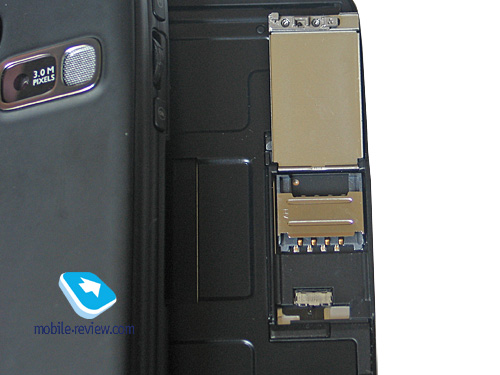

Back to the table of contents >>>
Controls, QWERTY-keyboard
The navigation cluster is located right below the display and comprises several controls. Its outer rim includes the pick/hand up keys and the Start menu buttons, as well as the OK key. And inside the cluster are two soft-keys, dedicated mail and browser buttons, while the centre is occupied by the five-way navigation key.


All these buttons are properly sized and offer the user relatively deep and solid travel, which leads us to the conclusion that this cluster is a joy to handle. All keys apart from the navi-pad are evenly lit in white.
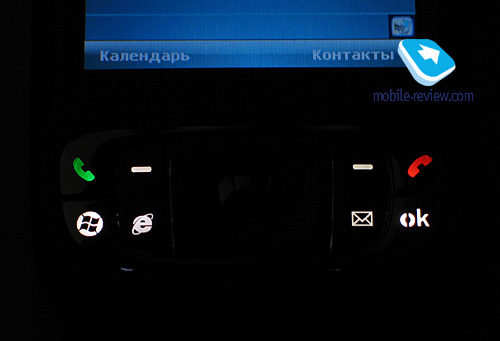
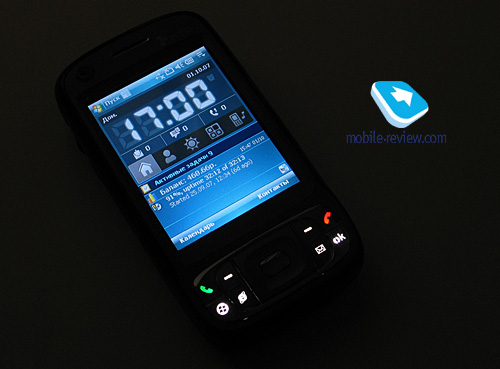
The thumbboard features 41 keys – two them, the soft-keys are placed beneath the slid-open display when the communicator. They are quite fiddly to use due to their placement – your finger keeps running into the top half’s edge above them. That’s why for all actions involving these two keys you better use corresponding on-screen menus.
The thumbboard itself is quite cramped – it even doesn’t use up the entire real estate of the bottom slide. Sitting on the left of the keyboard is the ambient light sensor, adjusting backlighting status (on/off) depending on the environment you are in. And right next to this sensor are Cap and Fn LED indicators.
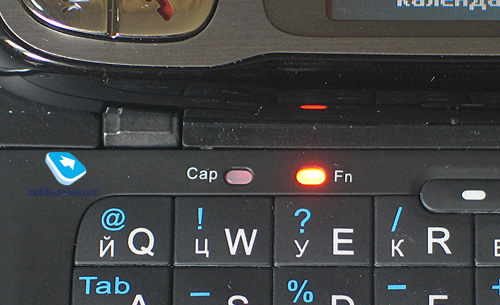
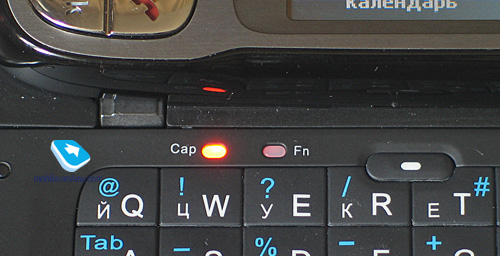
All keys in this thumbboard are rectangular in shape, the travel distance is relatively short and the truth is, the buttons are quite stiff, but generally you won’t experience much trouble handling this thumbboard. Typing up small texts, replying to messages – these are all good occasions to put the HTC TyTN II’s QWERTY-setup to good use. Key captions are made in white both for Cyrillic and Roman alphabets, while other symbols are marked in blue. The Russian layout is somewhat different from what we have used to, but thankfully the developers have managed to eschew two-letters-per-key layout or extra buttons.
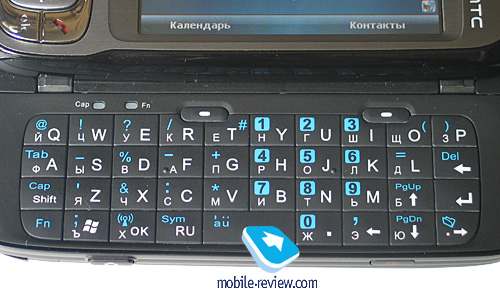
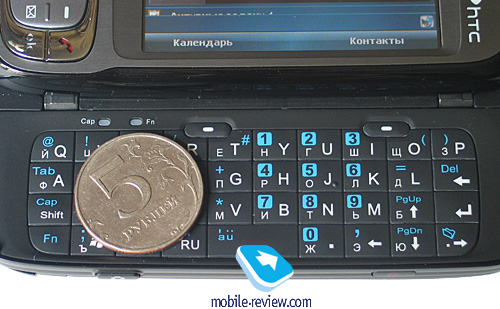
All keys are lit in white – the central part of the thumbboard, where numeric buttons have settled down, is a tad brighter than the rest of the slab, however this doesn’t cause any problem.
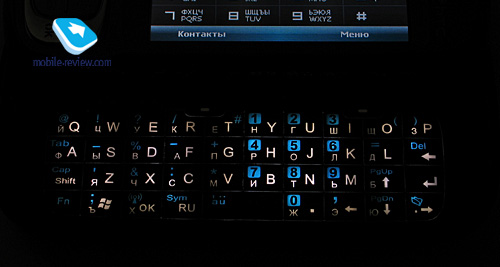
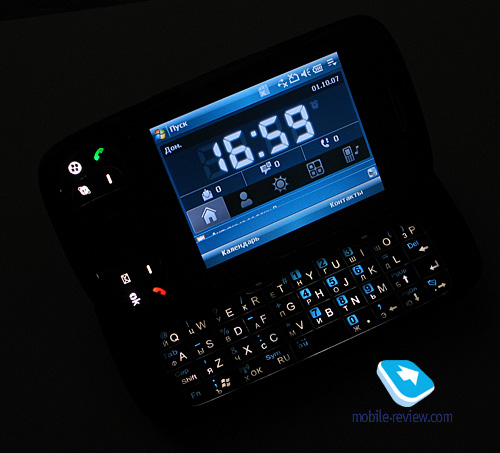
Like we have come to expect from HTC-branded communicators, the TyTN II allows you to reprogram any hardware button, expect for the navigation key and the power button.
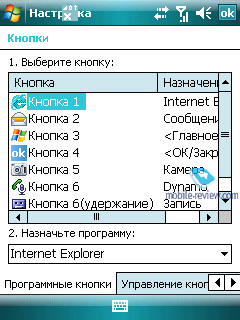
Back to the table of contents >>>
Display
The handset employs a 2,8-inch TFT matrix that enables a 240x320-pixel resolution and 65 K colors. While both vertical and horizontal viewing angles are fine, they aren’t the best thing we have seen yet – in this sense the TyTN II is pretty much in line with the HTC P3600. While in the sun, the display becomes extremely washed out, and you will be very unlikely to see something on it – down to searching for a proper angle again, which is the case with all Windows Mobile-powered devices.
The display’s brightness may be modified with the help of a 1 to 10 scale – the top brightness settings seem to be overkill on the TyTN II, as in most environments 7 or 8 is just enough. All up, it is a typical HTC’s display (color reproduction and saturation), belonging to the previous screen generation.
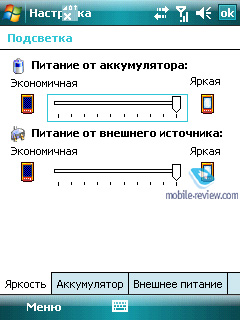
Back to the table of contents >>>
Camera
The communicator comes with a 3 MPix autofocus-enabled CMOS camera – a breakdown of its abilities will follow in a dedicated write-up, however already aware of that review’s final judgment, we have to say the HTC TyTN II’s camera is the best you can get on the Windows Mobile market, even given its lack of flash and dedicated macro mode.
Back to the table of contents >>>
Battery life
The TyTN II utilizes a 1350 mAh Li-Ion battery, which is the most commonly used unit among the today’s communicator. With average use (20-30 minutes of calls a day, 10-20 SMS, hourly mail checks, 1 hour of web-surfing a way), the communicator lasted for about two days. Should you get heavier on its feature pack, be ready for daily charging sessions.
Below is our standard test routine.
- Reading mode – the least power-hungry mode of all. Display backlighting level is set to the minimum that makes for comfortable reading, then we launch Haali Reader and activate auto-scrolling.
- MP3 mode – self-explanatory test. Display backlighting gets switched off (via standard tools or with the help of SPB Pocket Plus), volume level is set to the medium level, and then we link up the communicator with headphones and playback MP3-files with 128 Kbit/s bitrate via the default player.
- Maximum load – Display brightness is set to maximum, thereupon with start up Core Player and initiate playback of 320x240-pixel movies.

The communicator is a typical performer in the Music and Video modes and the Reading mode is where it does its best. But again, with average use the TyTN II lasts for around two days, which is pretty decent, given what it packs under the hood.
Back to the table of contents >>>
Performance
The HTC TyTN II is the company’s first device to run on a Qualcomm’s platform, and the next offering to pack the same thing is the HTC Touch Dual. But while the Dual doesn’t squeeze the most out of it, the TyTN II employs most of its abilities.
Basically, it is a very crucial experience for HTC – starting from the TyTN II, the Qualcomm’s platform becomes the primary option for the company. To get a better idea of why this very model utilize the platform in question and why HTC has already announced a couple more offerings running on Qualcomm, let’s run down its spec sheet.
The Qualcomm MSM7200 includes all major elements used in the today’s communicators. For all main OS tasks and bundled applications, it employs an ARM11 400 MHz CPU. On top of that this platform also packs an ARM9 274 MHz CPU, which is responsible for the communicator’s phone part, calls and operability of all required services. It comes with support for 3D graphics (Q3Dimension’s own technology) and prost-processing of sound. All navigation needs of the smartphones are satisfied by an own chip – gpsOne.
Furthermore, the platform brings more goods to the table, including the USB OTG (On-the-Go) technology – direct interactions between two devices with no PC required at hand, TV-Out support and others.
Such abilities like the 3D accelerator have been dumped in the HTC TyTN II, but obviously, the company has picked a platform with loads of potential going for it. As of today the Qualcomm MSM7200 appears to be a smart choice, for it simplifies the development process for the manufacturer. In fact, when dealing with OMAP, Marvell, Samsung platforms, makers normally need to enhance their functionality with extra modules (GPS, new connectivity options, radio modules), but in the case of Qualcomm, HTC gets every last thing it needs ready to be tweaked. If you look at the HTC Touch Dual’s size, you can easily conclude that on top of all these amenities, the platform is also reasonably compact, which adds even more value to it.
All enthusiasts are welcome to familiarize themselves with detailed specifications of the Qualcomm MSM7200.

Like we already said, the CPU runs at 400 MHz. The communicator ships with 128 Mb of RAM, out of which around 101 Mb is available for applications – this should be enough to allow for ten and more applications to run simultaneously on the TyTN II. The storage space that the user can manage makes 135 Mb, so you should experience no shortage in this department when it comes to most helpful and essential applications. And the rest can be thrown onto the memory card.
We have put the TyTN II though its paces with the help of the benchmarks built into Core Player and TCPMP. Rates of 100% indicate that videos in given resolution will be played back without any discernable slow-downs, frames might drop out only during dynamic scenes. And all performance rates better than 120-130% mean that the communicator’s power will be enough for perfect playback (no freezes or dropped frames) of videos in given resolution and quality.
First test conducted in CorePlayer – performance compared with the HTC TyTN and the glofiish M700.
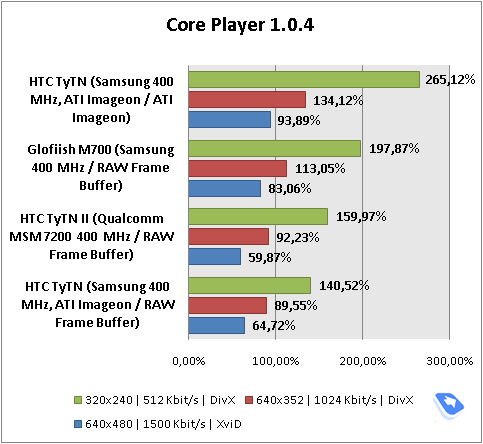
The diagram suggests that in terms of video rendering, the TyTN II lags behind the E-Ten’s offspring, and also its predecessor, which boasts AT Imageon accelerator. Furthermore, with this disabled, meaning that they all compete on an equal footing and CPUs become responsible for video rendering, the TyTN II turns out to be a hair ahead of the original TyTN. Just like its major rivals, this communicator can playback converted video clips with no freezes or slow-downs, but that’s about it. Basically, the chipset’s video rendering abilities are not employed by applications.
The second test is performed in TCPMP – here we put two models running on the same platform face to face.
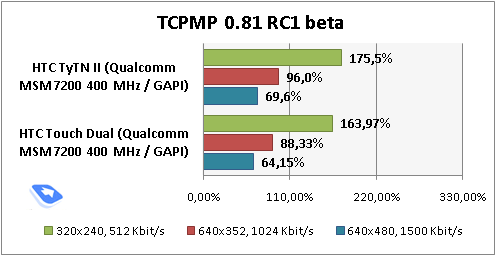
The HTC TyTN II trumps the Touch Dual, even though it is not that far ahead. Nonconverted clips are played back with some delays and freeze ups.
The model is quite speedy when it comes to menu navigation. Generally, you will feel right at home, in case you have some previous experience of using a contemporary communicator. And in standard applications (calls, text messages, mail checks) you won’t feel that marginal difference between the TyTN II and the models running on other 400 MHz CPUs.
Back to the table of contents >>>
Connectivity
The handset seamlessly taps into GSM (850/900/1800/1900) and UMTS (850, 1900, 2100). Both high speed data protocols are supported by the TyTN II – EDGE and HSDPA. The department of wireless connectivity option sports Wi-Fi and Bluetooth. For PC synchronization and data transfer purposes you can use the miniUSB cable shipping with the handset, apart from its Bluetooth wireless connectivity. The TyTN II employs USB 2.0 standard, whose speed, in theory, tops out at 480 Mbit/s, however in real life we copied a 10 Mb file onto the TyTN II over USB in 9-10 seconds.
For managing all wireless interfaces, the TyTN II utilizes an application from HTC’s suite of apps – Comm Manager.
The communicator also comes with Bluetooth 2.0+EDR module and already-standard Microsoft’s drivers. Below are running down the profiles available with the TyTN II and their purposes:
- Generic Access Profile (GAP). Provides the basis for all other profiles.
- Serial Port Profile (SPP). Emulates COM-connection of devices. Used mainly for synchronization with desktop PC, coupling external Bluetooth-gadgets, like Bluetooth GPS-receiver.
- Object Push Profile (OPP). A basic profile for sending "objects" such as pictures, virtual business cards, or appointment details.
- Hands-Free Profile (HFP). Connection of Bluetooth-headset and handsfree device.
- Headset Profile (HSP). The most commonly used profile, providing support for the popular Bluetooth Headsets to be used with mobile phones.
- Human Interface Device Profile (HID). Connection of Bluetooth-keyboard.
- Advanced Audio Distribution Profile (A2DP). Sound transfer via Bluetooth.
- Audio Video Remote Control Profile (AVRCP). Music playback management via wireless headset.
- Personal Area Network Profile (PAN). Network connection via Bluetooth, use for connection of a desktop PC to Internet through the communicator, replaces Dual-Up Networking profile..
- SIM Access Profile (SAP). Allows connecting to a SIM card in a phone with Bluetooth, so the car phone itself doesn't require a separate SIM card.
- File Transfer Profile (FPT)/ File Transfer Profile (FTP). Provides access to the file system on another device. This includes support for getting folder listings, changing to different folders, getting files, putting files and deleting files.
Handling a stereo-headset was very easy with the TyTN II – we had no problems pairing it with the device, nor did we experience any delays in sound or improper operation of controls. The sonic experience delivered by the communicator is pretty much fine, but if you are into music, wireless earphones may not be the best way to go.
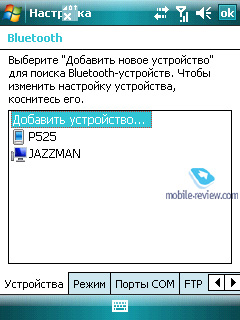
Wi-Fi 802.11b/g. The TyTN II’s Wi-Fi modules is a solid performer – we tested it with a Skype call made over Wi-Fi (your contact’s voice comes out of the loudspeaker).
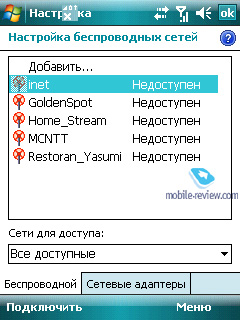
Back to the table of contents >>>
Software
The communicator runs on Windows Mobile 6 Professional. To learn more about the standard feature pack shipping with this operating system, go to our dedicated review.
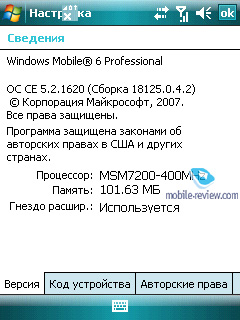
The suite of applications packed by the TyTN II is, let’s be honest, pretty scanty, however it is not what we have never seen coming as far as an HTC-branded model is concerned. This maker always ships almost no extra third-party software with its solutions. There are both positives and negatives (you need to find and install all utilities manually) to this approach. Let’s see what additional applications come preinstalled with the HTC TyTN II.
Java – emulator for applications written on Java. Its capabilities are very limited; in light of this fact 3D Java is not supported. In most cases support for Java-powered applications is not called-for on smartphones and communicators, since these days there are tons of applications for Windows Mobile. Some users make an exception for OperaMini as this app is simply the winner in the save-my-traffic contest. Another example - for Java-games addicts who need such emulator badly. However the regular emulator does not support additional libraries used for creation of Java applications for Nokia-, Motorola-branded and some other handsets. Hence nobody guarantees these applications will launch and operate properly.
Zip – HTC’s very own utility for handling archived files – you can either extract data from an archive, or add new to an already existing compressed file, as well as precisely adjust parameters of compressions.
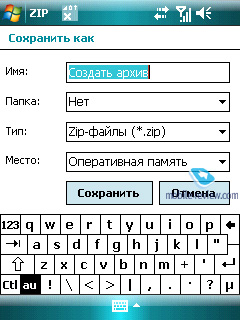
Audio Manager – application similar to the standard Media Player. In terms of the abilities this app doesn’t differ from the built in player, saving for the interface.
However the HTC’s own application packs tools for basic track editing, like cutting fragments so as to set them as ring tones afterwards. Now this operation is performed really easily, even a newcomer won’t have any problems with doing that – you pick a track, specify the fragment you need (in seconds or on the progress bar). For example, you can select a 6-minute long song and get take 30 seconds out of it by cutting off 2 minutes from the beginning and 3,5 minutes before the end.
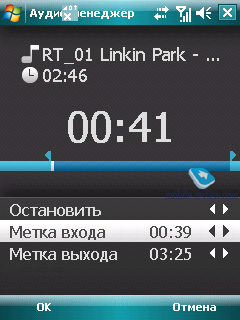
Adobe Reader LE – is the most widely adopted application for viewing PDF documents, and this is its mobile edition. Much like its elder brother, the applications never seems to be in a hurry. Loading a page takes about 10-15 seconds, should the document contain a considerable number of schemes and pictures each page will load for half a minute or even longer. It should be noted that for small files, the viewing capabilities, this application provides, are more than sufficient.
Streaming Media – used for playing streaming video and audio. In the Address field you specify the source and then the communicator starts uploading and playing back the content. In settings you will also be able to adjust Internet connection speed and buffer size.
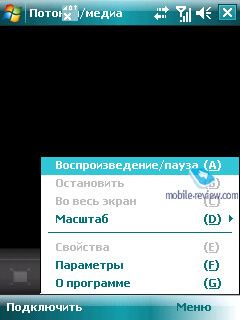
Voice recorder – the most basic application for recording voice clips; doubles as a player for playing back the recording you made, all sound clips can be set as call alert on-the-go.
Voice dial – self-explanatory application requires training, in other words, voice tags for specific contacts. However it does a pretty decent job, so having dealt with its settings once, you will never have to resetup it ever again.

WorldCard Mobile – serves for recognition of business cards and writes all information it can acquire from them into the contact list. But, just like many alternative applications, it is never the same twice – if you are lucky enough to place it properly and your business cards contain only plain data, this app should do just fine.
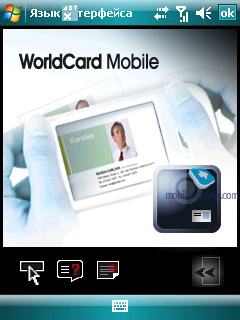
SPB GPRS Monitor – this application comes on the CD shipped with the communicator, so you will need to install it from this CD. To cut a long story short, this is a good tool for tracking your GPRS-Internet traffic statistics and calculating all GPRS-related expenses.
Task manager – with this utility Windows Mobile’s cross-shaped button can now actually terminate applications, rather than minimize them. Also, this program enables you to browse the list of currently running applications and memory volume that each of them takes up. While at the Today screen you will always find it in the top right corner – by tapping the icon you open a pop-up menu, which can close one or all applications at once.
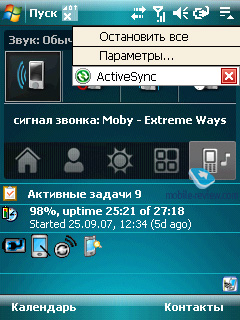
HTC Home – HTC's own skin for the Today screen is grabbing more features and getting more functionally rich overall. Whereas in the HTC Touch it had only three tabs, the HTC TyTN II boasts five of them: shortcuts to 9 applications, weather and time have been carried over from the HTC Touch. Now there are also tabs for contacts and sound profile. All these tabs are still housed in a horizontal bar and can be tapped with stylus or fingers.
TouchFLO
This technology, debuted with the HTC Touch, has been carried over to the new communicator along with HTC Home. Except for the additional cube-skin, called up with a finger sweep, other constituents and features of the TouchFLO technology are enabled in the HTC TyTN II (scrolling in lists, phonebook etc).
Back to the table of contents >>>
GPS
Like all other components of the communicator, its navigation department builds upon Qualcomm’s platform. The TyTN II’s navigator employs the gpsOne technology – in a word, this is a Qualcomm’s development, comprising a couple of tracking systems. In sum, there are four methods under its belt – satellites and three data processing systems (via carrier’s network) The simplest of them serves for adjusting the satellite’s data, the second stands for data update and the third – full fledged data reception via the carrier’s network, MS (mobile station)-Based, MS-Assisted and MS-Assisted/Hybrid respectively.
However our focus here is the conventional navigation method – via satellites. To back up our words with some figures, we put the navigation front of the HTC TyTN II with its Qualcomm solution up against the Gigabyte i350’s SiRF Star III.
The i350’s cold start time made around 30 seconds, for the TyTN II – roughly 40 seconds, no differences in launch times for next startups. Both communicators take around 15 seconds to locate a satellite, provided that you are outdoors.
Now as regards accuracy.
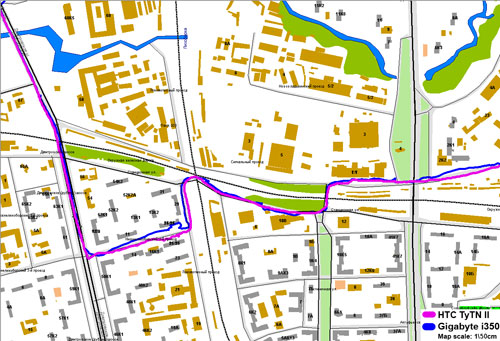
(+) maximize image
Comment: This image indicates that these two track your location in a similar fashion, deviations are seen both in the case of the i350 and the TyTN II
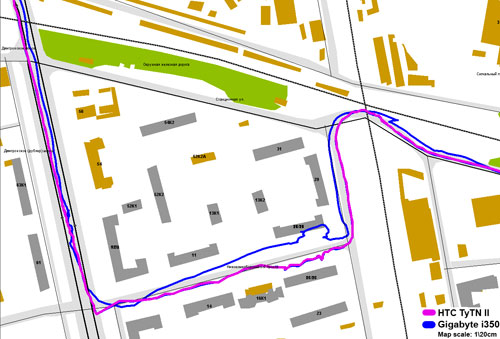
(+) maximize image
Comment: After zooming in, nothing seems to have changed, even though the i350’s deviation from the course is a tad more obvious. Zooming in even closer makes no difference as far as positioning accuracy is concerned.
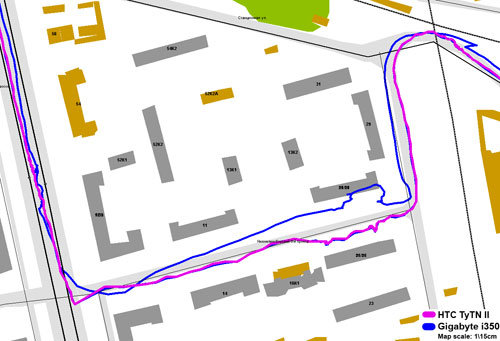
(+) maximize image
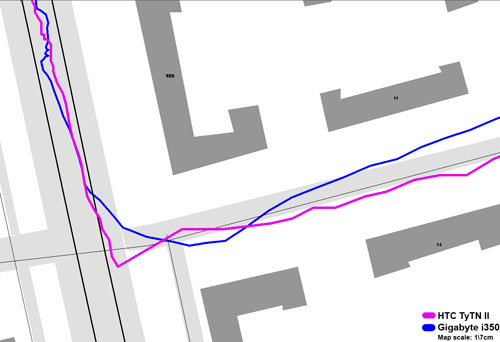
(+) maximize image
To prove our point, here is another example:
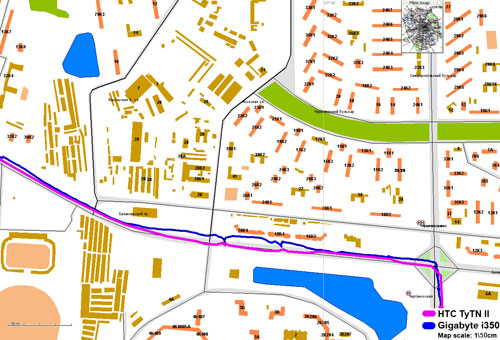
(+) maximize image
Comment: and again, pretty much smooth routes, but with some deviations.
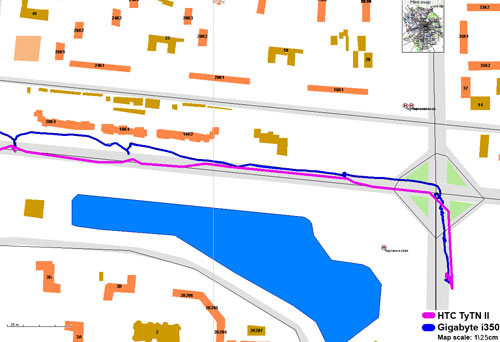
(+) maximize image
As the examples above indicate, the positioning accuracy achieved with Qualcomm’s GPS chipset is in line with the SiRF Star III. However, we should also note that the SiRF Star III powered unit we were using wasn’t the market’s finest offering – Gigabyte is not known for its GPS-solutions, so we must take account of this fact in our judgments. Obviously, Mio’s solutions would have made better samples of SiRF Star III. Nonetheless, even this comparison with the i350 lets you know that the Qualcomm solution’s accuracy is decent enough to keep you on track.
The handset ships with a full version of TomTom navigation app, and on top of that one free card is available for download (any city in Europe or the US).
The OS comes preinstalled with an application for handling GPS – QickGPS, which allows updating data on satellites via the Internet to speed the things up.
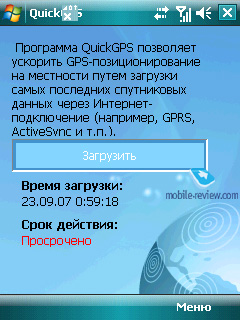
Back to the table of contents >>>
Sales package, sonic experience
The default headset appears to be nothing more than some Chinese dollar-worth unit, which is pretty irritating – normally, you don’t expect to find “this” in one box with a communicator retailing for more than 1000 USD.
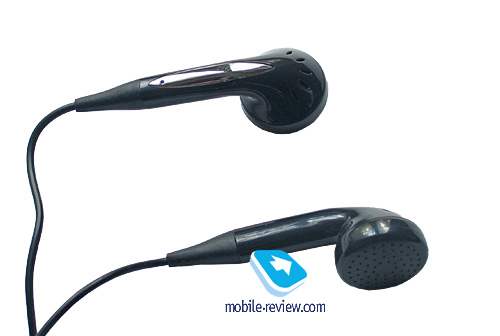
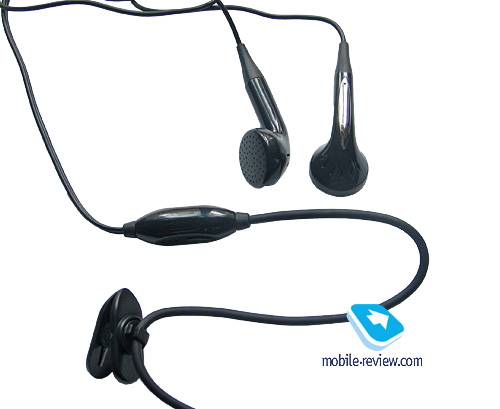
The sound quality provided by this accessory is acceptable when it comes to calls – obviously, for your music sessions you will need somewhat more potent solution, or, the best way to go, your favorite pair of headphones and an ExtUSB-3,5mm audio adapter.
On the brighter side, the belt case coming included with the TyTN II is much better – even though it is made not of leather, its shape is quite original. It firmly grasps the communicator once it is inside and is quite convenient in use.

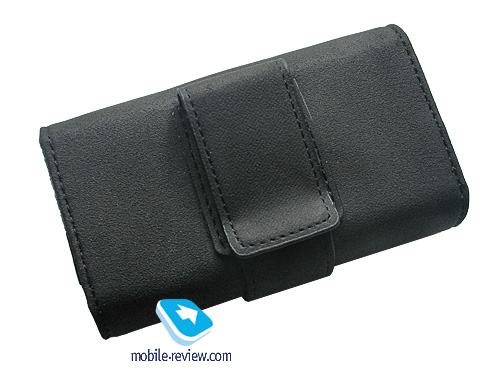

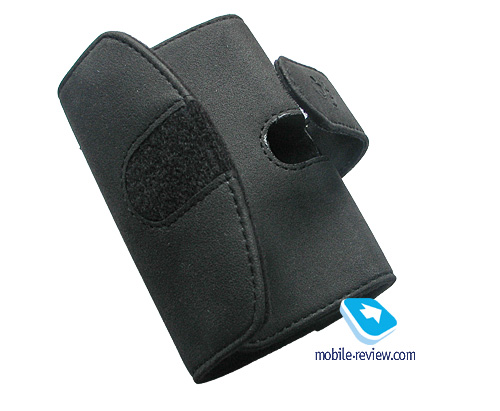

We tested the TyTN II’s sound quality with our standard RMAA benchmarks:
General performance
Frequency response (from 40 Hz to 15 kHz), dB: |
+0.18, -0.86 |
Average |
Noise level, dB (A): |
-81.2 |
Good |
Dynamic range, dB (A): |
81.5 |
Good |
THD, %: |
0.019 |
Good |
IMD, %: |
0.092 |
Good |
Stereo crosstalk, dB: |
-6.4 |
Very bad |
Intermodulation at 10 kHz, %: |
0.070 |
Good |
General performance: Average
Frequency response

Noise level

Alexander Dembovsky’s (editor of the Digital Audio section) comment:
The TyTN II does well for non-music-centric device. Its frequency response is pretty much smooth, however the lowest frequencies, 60 Hz and under, are quite a bust. Nevertheless, you are very unlikely to notice this with most headphones out there.
Drawing parallels with players, the TyTN II does a good job, being a solid mid-range performer, meaning that if you are into music, this communicator will provide you with acceptable sonic experience. All you have to do is find a good pair of earbud-style headphones or light clip-on earphones, for the output level of the TyTN II is not the greatest we have seen.
Back to the table of contents >>>
Conclusion
The TyTN II does well on the reception front. The communicator comes with 72-chord polyphony, however since a multitude of audio formats may be employed for ring tones, having this polyphony onboard is not vital at all. The volume of call alerts is average, which is still enough to make ring tones audible in typical environments. Also, during our calls, we had no complaints about how loud the other party sounded, even when we were in a busy street or a bus.
Apparently, this model will never be a wild success – its price tag, which will make around 1000-1500 USD on the launch day, is the major factor shrinking its target audience. However, there are some examples when HTC’s solution, even sporting a pretty bad price/quality ratio, stayed on top of the charts – like the HTC P3300 boasting navigation-related smarts inside. Although this model carries a hefty price tag, its functionality is in line or even lags behind the competition. Notwithstanding, it still enjoys its status of one of the most wanted communicators out there.
The HTC TyTN II may well have the same fate lying ahead, especially on the Russian market – its design is somewhat different from what we have come to expect from communicators, it is more of a top-notch handset, rather than a communicator as we know it. A price cut of 100-150 USD should have a positive impact on its sales.
Speaking of its price/quality ratio, and that’s usually the case with HTC-branded offerings, it is rather off. It is an enticing model with its bevy of features and most of those communicator’s abilities onboard – a thumbboard, navigation department, pretty decent camera – however they are charging the max for it. The market easily offers a dozen of alternatives for the same money, if you overlook the GPS department and have nothing against going for other platforms. And some true fans of Windows Mobile might be put off by its average CPU (performance-wise) and less-than-VGA-resolution display.
All up, these factors are one more proof of HTC’s ongoing strategy - step-by-step transition to mass-market models, elimination of Windows Mobile barriers, platform unification and faith in the brand’s image of the maker of classy and powerful solution.
Specifications:
- Type: communicator
- Form-factor: side-slider with screen tilting mechanism
- Position in the range: above HTC TyTN
- Rivals: glofiish M700, glofiish M800 (in the works)
- Materials used: plastic, soft-touch finish, metal
- Operating system: Windows Mobile 6 Professional
- CPU: 400 Mhz based on the Qualcomm MSM7200
- RAM: 128 Mb (101 Mb available to the user)
- ROM: 256 Mb, 135 Mb available to the user
- Connectivity: microSDHC (SDIO, any size), Bluetooth 2.0+EDR (A2DP), USB 2.0 for synchronization/charging, Wi-Fi (IEEE802.11b/g), proprietary headset socket, external GPS antenna slot
- Display: TFT 2.8” (active area - 43.2x57.6 mm), 240x320-pixel resolution , 65 K colors, adjustable backlighting brightness (1 to 10 scale)
- Extras: bundled Qualcomm (gpsOne) based GPS, screen tilting mechanism
- Battery: detachable 1350 mAh Li-Ion (pol) unit
- Dimensions: 112x59x19 mm
- Weight: 190 g (battery included)
Back to the table of contents >>>
Artem Lutfullin (artem.lutfullin@mobile-review.com)
Translated by Oleg Kononosov (oleg.kononosov@mobile-review.com)
Published — 29 October 2007
Have something to add?! Write us... eldar@mobile-review.com
|
